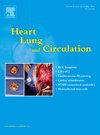The Modified History of Juvenile Rheumatic Mitral Stenosis Following Percutaneous Transmitral Commissurotomy: Intermediate-Term Outcomes From a Decadal Follow-Up Study
IF 2.2
4区 医学
Q2 CARDIAC & CARDIOVASCULAR SYSTEMS
引用次数: 0
Abstract
Aim
There are few studies that have looked at the long-term outcomes of juvenile mitral stenosis (JMS) following percutaneous transmitral commissurotomy (PTMC). This study sought to analyse the modified history of JMS in children following PTMC.
Method
We describe a longitudinal, observational follow-up study of all children and young adults aged <20 years who underwent PTMC at Sri Jayadeva Institute of Cardiovascular Sciences and Research, Bangalore, India from 2012 to 2021. Children were followed up for progression of mitral stenosis (MS), development of mitral regurgitation (MR), need for repeat interventions (percutaneous or surgical), and mortality.
Results
A total of 114 children and adolescents underwent the procedure. The mean age of children in the study was 15.1±2.5 years. After immediate procedural success, there was a tendency towards restenosis with respect to valve areas and transmitral gradients at follow-up. Severe MR after the procedure was noted in 2.6%. Compliance with penicillin prophylaxis was noted in 42.5%. The Kaplan–Meier survival estimate over 10 years showed a mortality rate of 1.98/100 patient-years and a re-intervention rate (re-do PTMC or surgery) of 5.50/100 patient-years. Additional valvular lesions were noted in 13.1% of children during follow-up. Severe symptomatic status at presentation (New York Heart Association class 4) was predictive of mortality, and children aged <15 years often needed re-intervention.
Conclusions
With a mortality rate of 6.1% and re-do intervention rate of 15.8% during extended follow-up, JMS has considerable healthcare implications in terms of morbidity and mortality in children and young adults.
经皮跨贲门憩室切开术后青少年风湿性二尖瓣狭窄的改良病史:十年随访研究的中期结果
目的:很少有研究关注经皮穿透性二尖瓣环切术(PTMC)后幼年二尖瓣狭窄(JMS)的长期预后。本研究旨在分析经皮二尖瓣环切术(PTMC)后儿童二尖瓣狭窄的改良病史:方法:我们对所有儿童和青少年进行了一项纵向观察性随访研究:共有 114 名儿童和青少年接受了该手术。研究中儿童的平均年龄为(15.1±2.5)岁。手术立即成功后,随访发现瓣膜面积和透射瓣梯度有再狭窄的趋势。术后出现严重 MR 的比例为 2.6%。42.5%的患者接受了青霉素预防治疗。卡普兰-梅耶尔十年生存率估计显示,死亡率为1.98/100患者年,再次干预率(再次进行PTMC或手术)为5.50/100患者年。13.1%的患儿在随访期间发现了其他瓣膜病变。患儿发病时症状严重(纽约心脏协会分级 4 级)是死亡率的预测因素,患儿年龄为结论年龄:JMS的死亡率为6.1%,在长期随访期间再次进行干预的比例为15.8%,对儿童和青少年的发病率和死亡率有相当大的医疗影响。
本文章由计算机程序翻译,如有差异,请以英文原文为准。
求助全文
约1分钟内获得全文
求助全文
来源期刊

Heart, Lung and Circulation
CARDIAC & CARDIOVASCULAR SYSTEMS-
CiteScore
4.50
自引率
3.80%
发文量
912
审稿时长
11.9 weeks
期刊介绍:
Heart, Lung and Circulation publishes articles integrating clinical and research activities in the fields of basic cardiovascular science, clinical cardiology and cardiac surgery, with a focus on emerging issues in cardiovascular disease. The journal promotes multidisciplinary dialogue between cardiologists, cardiothoracic surgeons, cardio-pulmonary physicians and cardiovascular scientists.
 求助内容:
求助内容: 应助结果提醒方式:
应助结果提醒方式:


